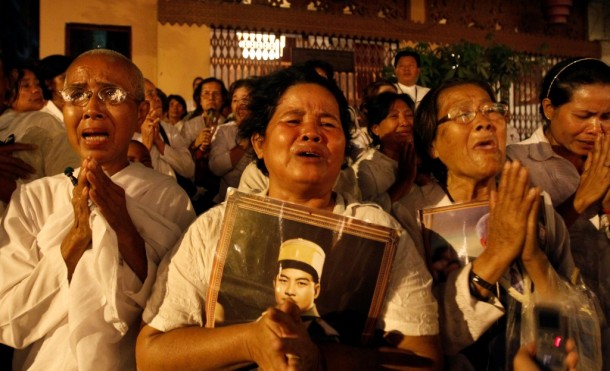PHNOM PENH, Cambodia — Tens of thousands of Cambodians gathered on Monday to pay their last respects to former King Norodom Sihanouk, a quixotic and much-loved figure who reigned during the country’s struggle for independence but was powerless to prevent decades of war.
Salvoes from an artillery salute shook the crowds that gathered along Phnom Penh’s Tonle Sap River as the embalmed body of the former monarch, who died aged 89 of heart failure on Oct. 15, was cremated in a gold casket by the Royal Palace.
The current King Norodom Sihamoni and Sihanouk’s widow, Queen Monineath, wept during the cremation as Cambodians poured into the capital to mourn the “king father,” as Sihanouk is known.
“This is the most sorrowful moment,” said Pal Ho, 58, a villager from the western province of Pursat, who carried with her six pictures of Sihanouk.
“When the king died, people were very sad. Even though we live so far away, we still come to pay our last respects,” she said prior to the cremation.
Elaborate Buddhist funeral proceedings began on Friday. Television, radio stations and restaurants have since been playing songs Sihanouk wrote and sang.
Sihanouk helped win independence from French colonial rulers but was later unable to stop his country being dragged into the Vietnam War despite his political wheeling and dealing that critics say precipitated a slide into chaos and the Khmer Rouge “killing fields” revolution.
Despite that, Sihanouk was revered by most Cambodians, few of whom speak critically of him.
The charismatic Sihanouk was groomed as France’s puppet king and took the throne in 1941 before defying his colonial masters and pushing for independence, which was achieved in 1953.
He abdicated in 1955, ostensibly to strengthen his political influence and became increasingly authoritarian to preserve that power. He was unpredictable, working with both sides in the Cold War and siding with communists who fought Americans in the Vietnam War.
After his ousting in a US-backed coup in 1970, Sihanouk made an ill-fated pact with Pol Pot’s Khmer Rouge, becoming a prisoner in his palace and losing five children and 14 grandchildren during the group’s 1975-1979 ultra-Maoist rule.
He was unable to prevent the deaths of 1.8 million of his people—a quarter of the population—from disease, exhaustion and execution under the Khmer Rouge.
He later led a royalist guerrilla faction in a three-party alliance that included the Khmer Rouge to oppose a Vietnamese occupation and fight a Vietnamese-backed government in Phnom Penh.
But in the eyes of his people, he was a unifying figure who worked for peace.
“He’s helped the country a lot, we can’t count how often,” said Touch Limhy, 80, from the eastern province of Kratie. “He has sent a message to us that if we are united, we don’t have to fight each other in order to live.”
More than 400 prisoners were to be freed in an amnesty to mark the occasion and Sihanouk’s ashes were due to be scattered across the Mekong River. The prime ministers of France, Jean-Marc Ayrault, of Thailand, Yingluck Shinawatra, and of Vietnam, Nguyen Tan Dung, laid flowers at Sihanouk’s casket.
As peace returned to Cambodia following a UN-brokered shift to a fragile democracy, Sihanouk retook the throne in 1993, but discovered his power and influence had waned significantly.
After 11 years, he abdicated again and lived for much of his time in China, where he spent his last days.
His son, Norodom Sihamoni, was crowned king and enjoys a largely ceremonial role, with far less power than Prime Minister Hun Sen, the “strongman” of Cambodian politics, whose 27-year grip on power Sihanouk could never loosen nor match.

















